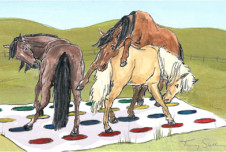When a tragic accident in 1995 left Craig Dobkin paralyzed below the waist, he and his business partner, Michael Terrien, decided to re-evaluate their lives. They left their careers as corporate consultants and founded Play for Peace, a nonprofit organization that promotes peace and fosters young leaders through children’s play.
More than a decade later, 1.5 million children have participated in Play for Peace worldwide, says Terrien, who now serves as the organization’s executive director. The program, which receives some of its funding from the United States Department of Education and the United Nations, has sites in areas where Terrien says cross-cultural tensions are common: the U.S., Guatemala, India, Northern Ireland, South Africa, and the Middle East.
Play for Peace is open to students of all ages, from elementary school through college. Students from different cultural backgrounds work together to create their own play activities. There’s only one rule: that every activity is nonviolent and noncompetitive. “Cooperative play is a way to build relationships and bring people together,” says Terrien.
The types of activities within the program range from physical ones, such as kayaking and building ropes courses, to less conventional forms of play. In Chicago, for instance, Northeastern Illinois University students facilitate the Play for Peace program through a partnership with local public schools. In one activity, children made 15-foot puppets and staged a show that tackled questions such as, “What does it mean to be a peacemaker?”
One of Play for Peace’s adult coordinators in Chicago, Langston Maynor, first joined the program eight years ago. It was shortly after he’d been expelled from high school for bringing a gun to campus. He says Play for Peace helped him diffuse the racially charged tensions he felt as an African-American student at his new, largely Latino charter school. “I saw change in myself, and I learned a lot about people.”
Now 23, Maynor says his job with Play for Peace helps him teach nonviolence to students who attend his old schools. “You have to get kids when they’re still young,” he says, “and teach them that’s not the only way to go.”




Comments